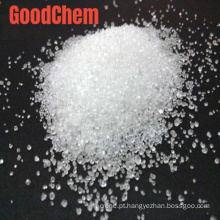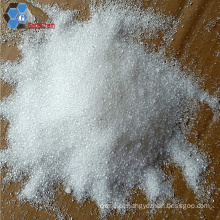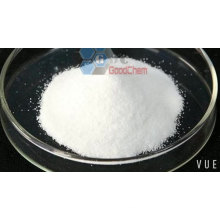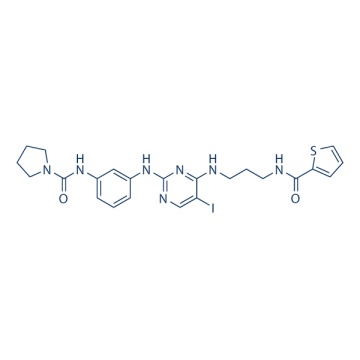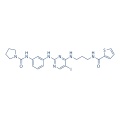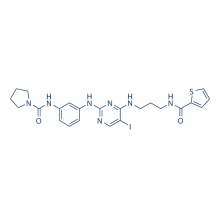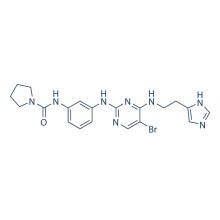.cp_wz table {border-top: 1px solid #ccc; border-left: 1px solid #ccc; } .cp_wz table td {border-right: 1px solid #ccc; borda inferior: 1px sólido #ccc; preenchimento: 5px 0px 0px 5px;} .cp_wz tabela th {border-right: 1px solid #ccc; border-bottom: 1px solid #ccc; preenchimento: 5px 0px 0px 5px;} \ n Peso molecular: 591,47 BX795 é um inibidor potente e específico de PDK1 com IC50 de 6 nM, 140 e 1600 vezes mais seletivo para PDK1 do que PKA e PKC, respectivamente. Enquanto isso, em comparação com GSK3β, mais de 100 vezes de seletividade observada para PDK1. \ N BX-795 bloqueia efetivamente a atividade de PDK1 em células PC-3, como mostrado por sua capacidade de bloquear a fosforilação de S6K1, Akt, PKCδ e GSK3β. BX-795 inibe potentemente o crescimento de células tumorais em plástico com IC50 de 1,6, 1,4 e 1,9 μM para células MDA-468, HCT-116 e MiaPaca, respectivamente. Em ágar mole, BX-795 exibe maior inibição de crescimento com IC50 de 0,72 e 0,25 μM para células MDA-468 e PC-3, respectivamente. Além disso, o BX-795, como um inibidor de TBK1 / IKKɛ, bloqueia a ativação mediada por TBK1 e IKKε de IRF3 e a produção de IFN-β. Nas respostas fisiológicas das plaquetas, o BX795 produz efeito inibitório na agregação induzida por 2-MeSADP ou induzida por colágeno, secreção de ATP e geração de tromboxano. \ n Protocolo (apenas para referência) Ensaio de cinase: [1]
|
Kinase assays
|
PDK1 is assayed in a direct kinase assay and a coupled assay format measuring PDK1- and PtdIns-3,4-P2-mediated activation of AKT2. For the coupled assay, the final assay mixture (60 μL) contained: 15 mM MOPS, pH 7.2, 1 mg/mL bovine serum albumin, 18 mM β-glycerol phosphate, 0.7 mM dithiothreitol, 3 mM EGTA, 10 mM MgOAc, 7.5 μM ATP, 0.2 μCi of [γ-33P]ATP, 7.5 μM biotinylated peptide substrate (biotin-ARRRDGGGAQPFRPRAATF), 0.5 μL of PtdIns-3,4-P2-containing phospholipid vesicles, 60 pg of purified recombinant human PDK1, and 172 ng of purified recombinant human AKT2. After incubation for 2 h at room temperature, the biotin-labeled peptide is captured from 10 μl of the assay mixture on streptavidin-coated SPA beads, and product formation is measured by scintillation proximity in a Wallac MicroBeta counter. The product formed is proportional to the time of incubation and to the amount of PDK1 and inactive AKT2 added. PDK1 is added at suboptimal levels so that the assay could sensitively detect inhibitors of AKT2 activation as well as direct inhibitors of PDK1 or AKT2. To measure PDK1 activity directly, the final assay mixture (60 μL) contained 50 mM Tris-HCl, pH 7.5, 0.1 mM EGTA, 0.1 mM EDTA, 0.1% β-mercaptoethanol, 1 mg/mL bovine serum albumin, 10 mM MgOAc, 10 μM ATP, 0.2 μCi of [γ-33P]ATP, 7.5 μM substrate peptide (H2N-ARRRGVTTKTFCGT), and 60 ng of purified recombinant human PDK1. After 4 h at room temperature, we add 25 mM EDTA and spotted a portion of the reaction mixture on Whatman P81 phosphocellulose paper. The filter paper is washed three times with 0.75% phosphoric acid and once with acetone. After drying, the filter-bound labeled peptide is quantified using a Fuji phosphorimager.
|
Ensaio de células: [1]
|
Cell lines
|
MDA-468, PC-3, HCT-116 and MiaPaca cells
|
|
Concentrations
|
~10 μM
|
|
Incubation Time
|
72 hours
|
|
Method
|
Cells seeded at a low density (1,500–3,000 cells/well, 0.1 mL/well, 96-well plates) are incubated overnight. Compound treatments are made by adding 10 μL/well of the compound in 1% dimethyl sulfoxide and growth medium (final concentration of dimethyl sulfoxide, 0.1%), followed by brief shaking. Treated cells are incubated for 72 hours, and viability is measured by the addition of 10 μL of the metabolic dye WST-1. The WST-1 signal is read in a plate reader at 450 nm, and a no cell, or zero time cell, background is subtracted to calculate the net signal. Results are reported as the average ± S.E. of two or more replicates.
|
Conversão de diferentes modelos de animais com base em BSA (valor com base em dados das diretrizes preliminares da FDA)
|
Species
|
Baboon
|
Dog
|
Monkey
|
Rabbit
|
Guinea pig
|
Rat
|
Hamster
|
Mouse
|
|
Weight (kg)
|
12
|
10
|
3
|
1.8
|
0.4
|
0.15
|
0.08
|
0.02
|
|
Body Surface Area (m2)
|
0.6
|
0.5
|
0.24
|
0.15
|
0.05
|
0.025
|
0.02
|
0.007
|
|
Km factor
|
20
|
20
|
12
|
12
|
8
|
6
|
5
|
3
|
|
Animal A (mg/kg) = Animal B (mg/kg) multiplied by
|
Animal B Km
|
|
Animal A Km
|
Por exemplo, para modificar a dose de resveratrol usada para um camundongo (22,4 mg / kg) para uma dose baseada na BSA para um rato, multiplique 22,4 mg / kg pelo fator Km para um camundongo e, em seguida, divida pelo fator Km para um rato. Este cálculo resulta em uma dose equivalente de rato para o resveratrol de 11,2 mg / kg.
|
Rat dose (mg/kg) = mouse dose (22.4 mg/kg) ×
|
mouse Km(3)
|
= 11.2 mg/kg
|
|
rat Km(6)
|
Informação Química
|
Molecular Weight (MW)
|
591.47
|
|
Formula
|
C23H26IN7O2S
|
|
CAS No.
|
702675-74-9
|
|
Storage
|
3 years -20℃Powder
|
|
6 months-80℃in solvent (DMSO, water, etc.)
|
|
Synonyms
|
|
|
Solubility (25°C) *
|
In vitro
|
DMSO
|
100 mg/mL
(169.07 mM)
|
|
Water
|
<1 mg/mL
(
|
|
Ethanol
|
<1 mg/mL
(
|
|
In vivo
|
30% PEG400/0.5% Tween80/5% propylene glycol
|
30 mg/mL
|
* <1 mg/ml means slightly soluble or insoluble.
* Please note that Selleck tests the solubility of all compounds in-house, and the actual solubility may differ slightly from published values. This is normal and is due to slight batch-to-batch variations.
|
|
Chemical Name
|
N-(3-(5-iodo-4-(3-(thiophene-2-carboxamido)propylamino)pyrimidin-2-ylamino)phenyl)pyrrolidine-1-carboxamide
|
Calculadora de molaridade Calculadora de diluição Calculadora de peso molecular
Grupo de Produto : PI3K / Akt / mTOR > Inibidor PDK-1
